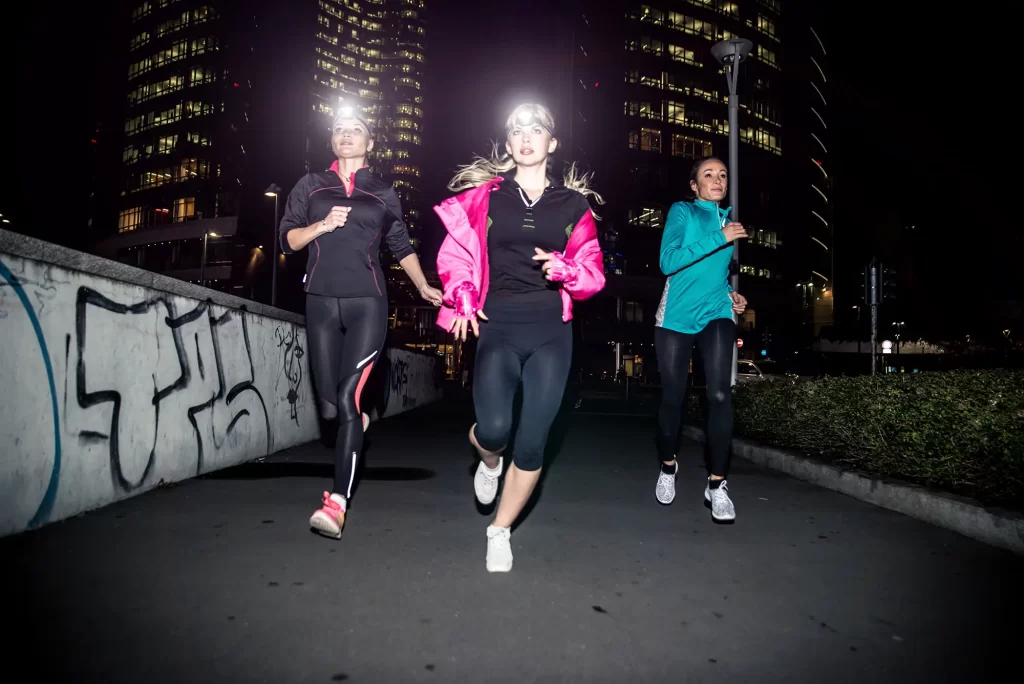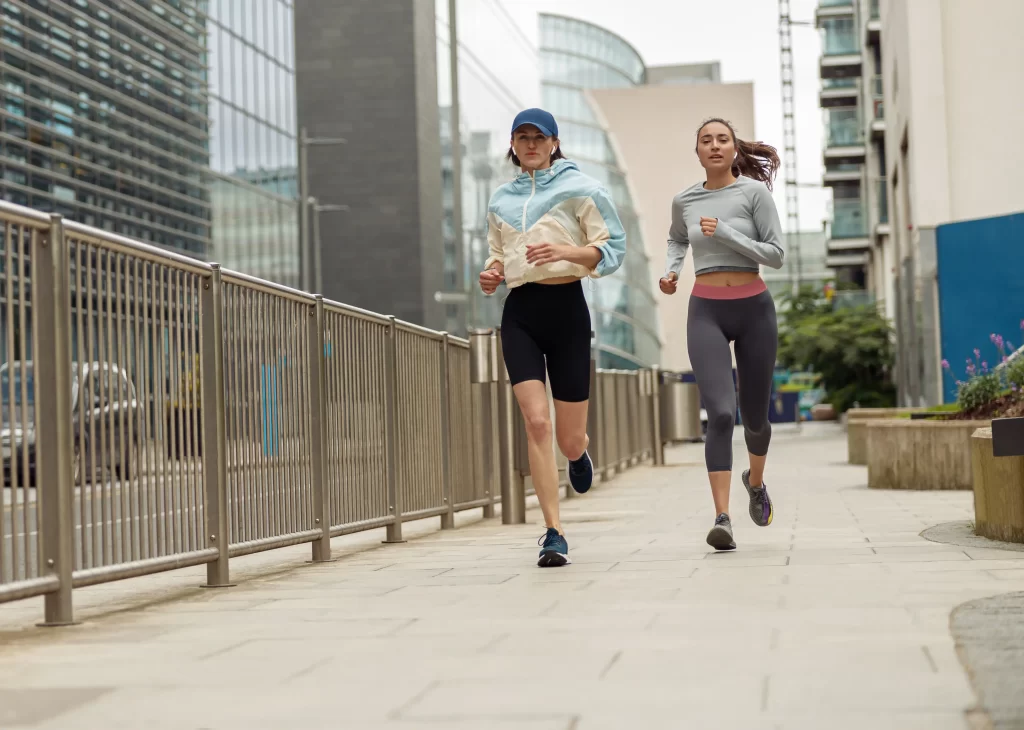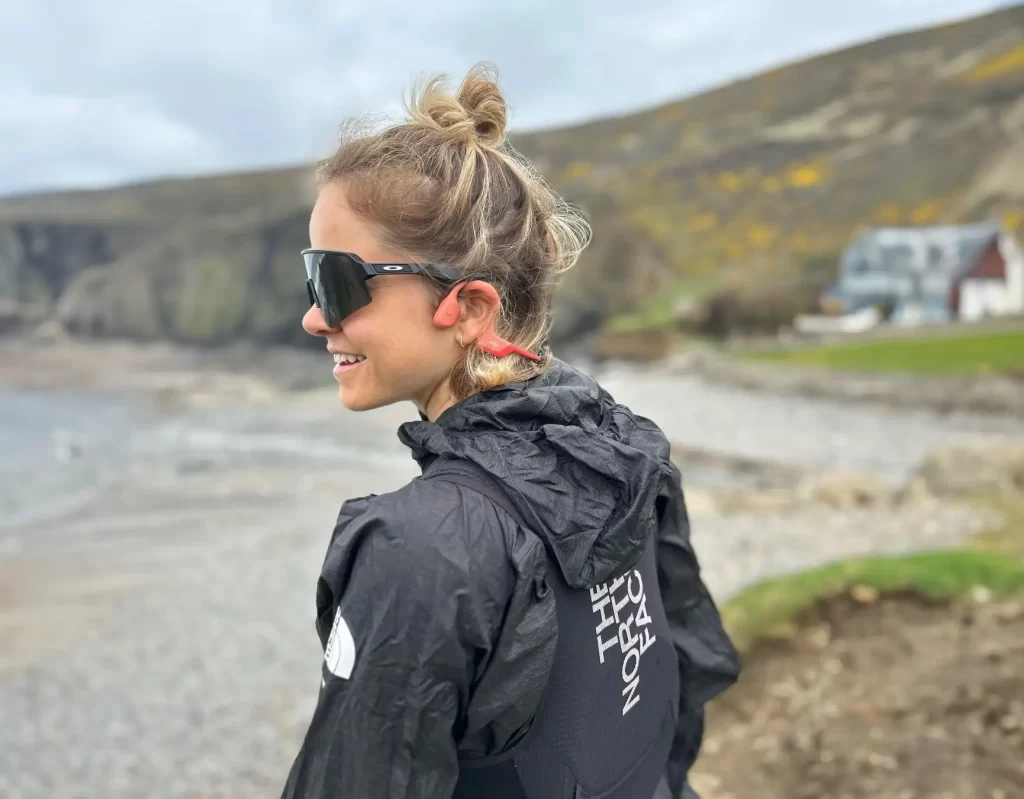Running has always been more than just a workout for me; it’s a journey of self-discovery, a test of limits, and a way to connect with nature. But as exhilarating as it is, running also brings its share of risks. I remember reading a statistic that struck a chord: “Motorists who speed and fail to give runners a wide berth pose a significant risk to the safety of runners.” There were over 14,000 pedestrian injuries in road traffic accidents in 2020 and 355 fatalities. This figure was a wake-up call, emphasising that safety isn’t just an option but a necessity.
As a runner, I’ve experienced various terrains and conditions – the peaceful yet unpredictable trails, the busy urban streets, and the serene but challenging night runs. Each setting has unique hazards, from uneven paths in the woods to the city’s relentless traffic. The tranquil isolation of night runs, while meditative, can also heighten vulnerabilities.
Safety in running isn’t a one-size-fits-all approach. It demands adaptability and awareness. In the woods, I learned to be vigilant of roots and rocks, mindful of the wildlife, and respectful of nature’s unpredictability. On city streets, my senses are attuned to the rhythm of traffic, the signals, and the unwritten rules of urban running. Night running, a personal favorite, requires an extra layer of caution – being visible with reflective gear and choosing well-lit paths.
Through my running journey, I’ve realized that safety is as much about mental preparedness as it is about physical readiness. It’s about planning your route, understanding your environment, and being equipped for emergencies. It’s a commitment to return from each run not just fulfilled, but unharmed.
In this article, we’ll explore the multifaceted world of running safety. From pre-run preparations and tailored advice for different terrains to post-run practices, I’ll share insights and experiences, aiming to equip you with the knowledge for a safer, more enjoyable run. Whether you’re navigating the quiet trails, pacing through the bustling streets, or embracing the calm of the night, remember that your safety is paramount. Let’s dive into the world of running with caution as our trusted companion.

Pre-Run Preparations
Before lacing up my running shoes, I always take time for thorough preparation. This ritual has not just enhanced my running experience but has been crucial for my safety.
Planning Your Route
- Selecting safe, well-lit, and populated areas has been a cornerstone of my running routine. I prefer routes with ample lighting and some foot traffic, which offer both visibility and a sense of security. My rule of thumb is avoiding secluded or poorly lit paths, especially for evening runs.
- Familiarizing myself with the chosen path is equally essential. I usually scout new routes during daylight hours to get a sense of the terrain, potential hazards, and landmarks. This reconnaissance helps me navigate confidently, even when my focus is divided between the path and physical exertion.
- Informing a friend or family member about my route and expected return time is a practice I never skip. It’s reassuring to know someone is aware of my whereabouts, especially when venturing into less populated areas.
Weather and Attire Considerations
Checking the weather forecast is a step I integrate into my pre-run routine. Adapting my attire to the weather not only ensures comfort but also safety. For instance, on hot sunny days, I opt for breathable fabrics to prevent overheating, while on colder days, layering appropriately helps maintain body warmth.
Reflective gear is my go-to for low-light conditions. Whether it’s a reflective vest, bands, or even shoes with reflective elements, ensuring I’m visible to others, particularly motorists, is vital.
Comfortable footwear, tailored to the terrain, has been a game-changer for me. I choose shoes that provide adequate support and grip, which vary depending on whether I’m hitting the pavement, trails, or the track.
Health and Safety Essentials
Carrying identification and a charged phone has become non-negotiable in my running kit. In unexpected situations, these items are crucial for safety and getting assistance.
Proper hydration and nutrition are the fuels that power my runs. I ensure to hydrate well before starting and carry a small water bottle during longer runs. For nutrition, a light snack like a banana or an energy bar, consumed about 30 minutes before the run, provides the necessary energy without overburdening my stomach.
These pre-run preparations, cultivated from years of running, form the foundation of a safe and enjoyable running experience. They’re not just routines; they’re safeguards that enable me to focus on the joy of running, knowing I’ve taken the necessary steps to ensure my safety.
Tailoring Safety to Your Terrain: A Deep Dive
As a runner, adapting to different terrains and environments is essential for a safe and enjoyable experience. Here’s a deep dive into how I tailor my safety practices for various running settings.
Road Running Safety
Visibility and Awareness
- Running Against Traffic: I always run against traffic, particularly around blind curves or hills, to ensure better visibility by drivers. It’s crucial to see and be seen.
- Bright and Reflective Clothing: Wearing brightly colored or reflective clothing is a practice I follow religiously, especially during pre-dawn or dusk runs when visibility is low.
- Illumination Tools: I often use headlamps or clip-on lights to enhance my visibility. These are particularly useful in poorly lit areas and during early morning or evening runs.
- Pavements and Running Paths: Whenever possible, I use sidewalks or designated running paths. These not only provide a safer running surface but also reduce conflicts with vehicular traffic.
- Mindfulness Around Parked Cars: I stay alert for parked cars and avoid running too close to them, especially to avoid the risk of sudden door openings.

Traffic Rules
Obeying traffic signals and using crosswalks is a non-negotiable part of my road running routine. It helps in avoiding unnecessary risks.
At intersections or turning points, I always yield to vehicles, ensuring that I make eye contact with drivers to confirm my intentions.
When changing directions, I use hand signals to communicate my moves to drivers, enhancing mutual understanding and safety.
Trail Running Insights
Trail Selection
Choosing trails that match my skill level and fitness is important. I research trails for potential hazards and start with easier ones, gradually progressing to more challenging paths.
Informing someone about my planned trail and expected return time is a step I never overlook.
Natural Obstacles
On trails, I remain focused and anticipate obstacles like roots, rocks, or uneven surfaces, adjusting my pace and stride accordingly.
Wildlife Safety
In areas with wildlife, I carry bear spray and stay informed about the local wildlife, making noise to alert animals of my presence.
Night Running Protocols:
Reflective Gear
Reflective vests, jackets, or armbands are essential. I also use reflective ankle bands or shoe clips for extra visibility.
Headlamp Power:
Choosing a headlamp with sufficient brightness is crucial. I carry extra batteries or a rechargeable headlamp for longer runs and adjust the beam to avoid blinding myself or others.
Safety in Numbers
When running at night, especially on isolated trails, I prefer the company of a partner or a group. This not only enhances safety but also adds to the enjoyment.
Remember:
- Adapting safety measures to the specific terrain and conditions is key.
- Trusting my intuition and being prepared to change my route if needed.
- Carrying a whistle or personal alarm for emergencies.
Prioritising safety in different terrains has not only enhanced my running experiences but also ensured that I return from each run safe and sound, ready to lace up for the next adventure.
Mid-Run Vigilance: Keeping Your Senses Sharp
Running is not just a physical activity but a sensory experience requiring acute awareness. Here’s how I ensure my senses stay sharp and vigilant during every run:
Best Practices for Headphone Harmony
- I switched to bone-conduction headphones, which transmit sound through my jawbone. This technology leaves my ears open, allowing me to stay tuned to my surroundings while enjoying my playlist.
- When I use traditional earbuds, I keep one ear free. It’s a simple yet effective way to balance the joy of music with the necessity of environmental awareness.
- Keeping the volume at a level where I can hear both my music and the ambient sounds is crucial. It’s a delicate balance that ensures I’m not caught off-guard by approaching vehicles or other runners.
- Sometimes, I alternate between listening to music and brief periods of silence. This tactic heightens my awareness and keeps me attuned to the changing sounds of my environment.

Trusting Your Gut Instinct
- That subtle sense of unease has often guided my decisions. Whether it’s a secluded path or an approaching figure, I trust my gut and react accordingly if something feels off.
- I regularly shift my gaze and use my peripheral vision to stay aware of my surroundings, ensuring I’m focused on the path ahead and what’s around me.
- I never hesitate to change my route if something doesn’t feel right. Safety always takes precedence over a planned path.
Empowering Yourself with Tools
- A personal alarm or whistle is part of my gear. The loud sound can be a significant deterrent in an emergency and can attract help if needed.
- I’ve researched local regulations regarding pepper spray. It’s a last-resort tool for me, and I’ve familiarized myself with its proper usage.
- Reflective clothing and accessories are essential, especially for runs during dawn, dusk, or in shaded areas. They significantly improve my visibility to others.
Self-Defense Smarts and De-Escalation Tactics
- Learning basic self-defense techniques, like escape holds and blocks, has boosted my confidence. Knowing I can defend myself is empowering.
- I practice de-escalation techniques, focusing on calm, assertive communication. Avoiding confrontation and creating distance is often the best defense.
- As a runner, my first line of defense is to use my ability to run. Escaping a threat is always my preferred option.
Bonus Tips
- Sharing my route with someone before heading out is a practice I never skip.
- Running in groups, particularly in less frequented areas, adds a layer of safety.
- Carrying a fully charged phone with emergency contacts is a must.
- Recognizing the signs of fatigue is vital, as it can impair judgment and awareness.
Post-Run Practices: Winding Down Wisely
The finish line isn’t the end; it’s the beginning of preparing for the next run. My post-run practices are as essential as the run itself, focusing on recovery, reflection, and planning. Here’s how I wind down wisely:
Cool Down and Recovery:
- I never skip the cooldown. I dedicate 5-10 minutes to static stretches targeting the major muscle groups I’ve used. This routine helps in improving flexibility, reducing muscle soreness, and maintaining a good range of motion, which is vital for my next run.
- Hydration is key. I usually drink water or an electrolyte-rich sports drink to replenish lost fluids and minerals. For nutrition, a snack combining carbohydrates and protein is my go-to for muscle repair and energy replenishment.
- I pay close attention to how my body feels post-run. Any unusual aches or pains are noted. While minor soreness is typical, sharp or lingering pain gets extra attention, often leading to ice packs, foam rolling, or even a visit to a healthcare professional if necessary.
Reflection and Planning
- Post-run, I reflect on the safety aspects of my run. Were there any close calls or areas for improvement? Did I follow all my safety protocols effectively? This reflection helps me fine-tune my strategies for future runs.
- I consider the suitability of my chosen route. Was it the right fit for my skill level and the lighting conditions? Next time, might a different path offer increased safety or a change of scenery?
- Evaluating my gear is crucial. Did my shoes provide the right support? Was my reflective gear reflective throughout the run? This assessment often leads to investing in gear upgrades for enhanced safety and comfort.
Sharing with the Community
- I believe in sharing my experiences and tips with fellow runners. Discussing challenging situations and how I handled them helps inspire others to be vigilant.
- I actively seek out and share local running resources like safety groups, well-lit paths, and emergency contacts. Sharing this knowledge helps strengthen the safety net for the entire running community.
- Promoting safety within the running community contributes to a culture of shared responsibility and proactive risk management. It’s about making the running world a safer place for all.
Incorporating these post-run practices ensures that every run is not just enjoyable but also a step towards a safer running future. It’s about creating a sustainable running journey, where safety and enjoyment go hand in hand, encouraging a lifetime of fulfilling and secure running experiences.
Conclusion
As we reach the end of our exploration into running safety, it’s crucial to underline the key takeaways that can transform our running experiences from mere physical exertions to mindful journeys of safety and enjoyment.
Safe running starts long before the first step. Choosing well-lit, familiar routes, informing someone about your plan, and being weather-wise are essential practices. Equip yourself with the right gear, ensuring you’re visible and comfortable, and don’t forget the importance of proper hydration and nutrition.
Each terrain presents unique challenges. On roads, be visible and vigilant, always mindful of traffic. Trails call for an awareness of natural obstacles and wildlife, demanding respect for nature’s unpredictability. Night runs require enhanced visibility measures and, if possible, the safety of numbers.
Maintaining vigilance during your run is vital. Whether it’s through mindful headphone use, trusting your intuition, or carrying personal safety tools, staying alert to your surroundings is non-negotiable.
Winding down wisely with proper cooldowns, body replenishment, and gear checks is as crucial as the run itself. Reflect on your safety practices and plan for improvements in future runs.
Finally, I invite you to be proactive in your approach to running safety. Don’t just read and forget; implement these strategies in your runs. Share your experiences, learn from others, and maybe even inspire someone new to running to adopt these safety habits.
Remember, running is not just about speed, distance, or endurance. It’s about creating experiences that are safe, enjoyable, and fulfilling. By prioritizing safety in every stride, we not only protect ourselves but also contribute to a safer running community. Here’s to many more miles of safe and enjoyable running!
